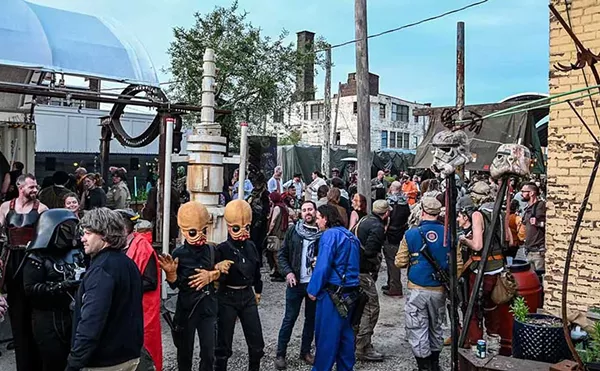
Audio By Carbonatix
[
{
"name": "GPT - Leaderboard - Inline - Content",
"component": "35519556",
"insertPoint": "5th",
"startingPoint": "3",
"requiredCountToDisplay": "3",
"maxInsertions": 100,
"adList": [
{
"adPreset": "LeaderboardInline"
}
]
}
]
A stunning example of all-out, go-for-broke creative risk-taking on a massive scale, this audacious adaptation of Leo Tolstoy's War and Peace redefines the epic film. Writer, director and star Sergei Bondarchuk transformed one of Russia's most revered texts into one of the most expensive movies ever made, and he did it in the former Soviet Union during the years (1965-67) when Hollywood studios nearly collapsed under the weight of bloated, big-budget flops like 1963's Cleopatra.
What sets War and Peace apart from other lavish historical dramas — including the stilted Doctor Zhivago (1965) — is Bondarchuk's belief that a great epic tale is about more than visual grandeur (although he certainly spared no expense there), but must be emotionally expansive as well. He makes the film as much about the internal journeys of the characters as the huge social and political upheavals of Russia during the Napoleonic era.
At nearly seven hours, War and Peace is a mind-blowing endurance test. Nothing succeeds like excess, and this ambitious, overblown literary spectacle seeks to capture nothing less than the soul of Russia onscreen. Bondarchuk may not have achieved that goal, but it wasn't for a lack of trying.
War and Peace follows three members of the aristocracy forced to reassess their belief systems: the stoic soldier Andrei Bolkonsky (Vyacheslav Tikhonov), his aimless, intellectual friend Pierre Bezukhov (Bondarchuk), and the spirited Natasha Rostova (former ballerina Liudmila Savelyeva), whom they both would come to love.
Throughout, the camera caresses the trappings of titled nobility with such unabashed fervor that the film could easily qualify as decadent propaganda in the old USSR. But this portrait of prerevolutionary Russia is very much a product of its time. Bondarchuk sees a nation united by a common enemy, and shows the upper classes becoming noble by getting down and dirty in the Russian soil.
The first part of War and Peace is strongest, filled with a crazy, restless energy that blends Sergei Eisenstein's spirit of invention with the cocky brashness of Orson Welles, all while succinctly establishing Tolstoy's themes and story threads through voice-over narration (expressing the thoughts of individuals and the creator's voice of moral authority).
From stunning aerial photography and tilt-a-whirl camerawork, to the lush, oversaturated colors, the widescreen images are created with a painterly eye, one that appreciates clean, formal compositions, yet can also create moments of hallucinatory beauty.
That momentum sags when focusing on Natasha's romantic vicissitudes, and War and Peace grows much more stolid and straightforward as it enters the final chapters, which contain immense battle scenes of spectacular and brutal combat that are wrenching without being Sam Peckinpah bloody.
As if suddenly burdened with the knowledge of just how much information he has to convey, Bondarchuk shifts to more traditional forms of storytelling, less Battleship Potemkin and more Gone with the Wind. But like his characters, he finds triumph even in defeat. This huge spectacle is actually an idealistic treatise, and maybe Bondarchuk can't change cinema, but he can certainly change minds.
Showing at the Detroit Film Theatre (inside the DIA, 5200 Woodward Ave., Detroit). War and Peace, part 1 shows at 7 p.m. on Friday, Sept. 28. Part 2 shows at 7 p.m. on Saturday, Sept. 29. On Sunday, Sept. 30, part 1 shows at 2 p.m., and part 2 shows at 7 p.m. Separate admission for each part. Call 313-833-3237.
Serena Donadoni writes about film and culture for Metro Times. Send comments to letters@metrotimes.com.





